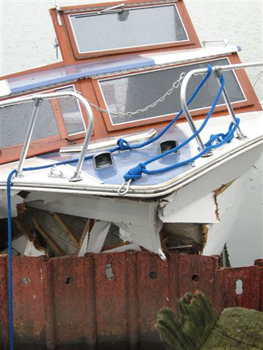Accident Reporting
Download a Boating Accident Report Form (pdf).

If your vessel is involved in an accident in which only property damage occurs, the operator must exchange information with the other parties involved. If the other party cannot be located the accident must be reported to law enforcement as soon as physically able. Failure to do so will result in a violation, resulting in a fine of not less than $100 nor more than $250.
If your vessel is involved in an accident in which personal injury occurs or someone disappears under the water, the operator must exchange information with the other parties involved. If the other party cannot be located or if they are incapable of receiving such information then the accident must be reported to law enforcement as soon as physically able. Failure to comply with these provisions shall be considered:
- 1st violation – Class B misdemeanor, $250 to $500;
- Subsequent violations within 5 years - Class A misdemeanor, $500 - $1000.
An accident involving a serious physical injury, death or disappearance in which the operator fails to stop will constitute a Class E felony. Recreational vessels operating in a commercial capacity are not exempt from any of these provisions.
Persons involved in a boating accident in which there was an injury, death, disappearance or damage in excess of $1000 must report the matter in writing to State Parks within 5 days of the incident. A violation of this subdivision shall be punishable by a fine of $25 to $100.
Rendering Assistance (Good Samaritan Law)
According to Section 41.3 of the Navigation Law:
It shall be the duty of every master or pilot of any vessel to render such assistance as he can
possible give to any other vessel coming under his observation and being in distress on account of accident, collision or
otherwise.
If you come across another vessel that is in distress, the law requires you to assist them to the best of your abilities. You are excused from this duty if such assistance:
- endangers your own vessel
- endangers your passengers
- interferes with other rescue efforts or law enforcement
- will cause further or more extensive damage
If you do find yourself in a position to help someone in distress, whether you are in a boat or on shore, you should try to remember the Rescue Sequence.
- REACH
The safest type of rescue is to convince the victim to swim to shore themsleves if they are close enough, or to try and reach them with a pole, ladder, stick or other long item. Reaching for the victim keeps you on shore, and out of harms way. - THROW
Using the Throw method, you attempt to resce the victim from shore by throwing a line or floating object. After safely anchoring yourself, you can pull them to safety without ever having to enter the water yourself. - ROW
In this method you use a boat to approach the victim and help them out of the water. Care must be taken not to let them capsize your boat, dumping you in the water. Remember that the victim may be tired and need help getting on board your boat. Also be conscious not to overload your boat, again putting yourself at risk. - GO
The Go method is clearly the most dangerous to your safety, and should only be attempted in extreme peril or by trained lifesavers. This rescue entails you entering the water and making personal contact with the victim. Dangers include the possibility that the victim will panic, grasp at you, and drag you under the water. A further danger lies in the effort that will be necessary to swim the victim to shore. If you must enter the water be sure to wear a life jacket, and bring a floatation device for the victim to hang onto.


